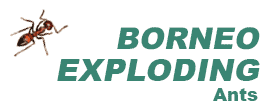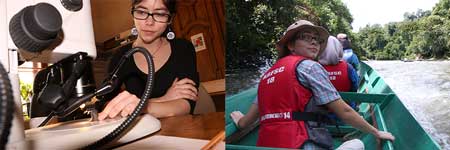Our latest paper "Colobopsis explodens sp.n., model species for studies on "exploding ants" (Hymenoptera, Formicidae), with biological notes and first illustrations of males of the Colobopsis cylindrica group" presenting the first new COCY species described within the project, has been accepted by the open access journal ZooKeys and will be published soon!"
Supplementary video for the manuscript:
Colobopsis explodens sp.n., model species for studies on “exploding ants” (Hymenoptera, Formicidae), with biological notes and first illustrations of males of the Colobopsis cylindrica group
Alice Laciny1,2, Herbert Zettel1, Alexey Kopchinskiy3, Carina Pretzer3, Anna Pal1, Kamariah Abu Salim4, Mohammad Javad Rahimi3, Michaela Hoenigsberger5, Linda Lim6, Weeyawat Jaitrong7 & Irina S. Druzhinina3
- 2nd Zoological Department, Natural History Museum Vienna, Burgring 7, 1010 Vienna, Austria
- Department of Theoretical Biology, Althanstraße 14, 1090 Vienna, Austria
- Research Area Biochemical Technology, Institute of Chemical, Environmental and Biological Engineering, TU Wien, Gumpendorfer Straße 1a, 1060 Vienna, Austria
- Environmental and Life Sciences, Universiti Brunei Darussalam, Jalan Tungku Link, Bandar Seri Begawan BE 1410, Brunei Darussalam
- Center for Analytical Chemistry, Department of Agrobiotechnology, University of Natural Resources and Life Sciences, Vienna (BOKU), Konrad-Lorenz-Straße 20, 3430 Tulln, Austria
- Chemical Sciences, Universiti Brunei Darussalam, Jalan Tungku Link, Bandar Seri Begawan, BE 1410, Brunei Darussalam
- Thailand Natural History Museum, National Science Museum, Technopolis, Khlong 5, Khlong Luang, Pathum Thani, 12120 Thailand.
Corresponding author: Alice Laciny ([email protected])
Acknowledgements:
We are thankful to Diane W. Davidson for introducing us to the diversity of Colobopsis cylindricaants at KBFSC and for passing down her knowledge on the ecology of these organisms. We thank the administration of KBFSC and Universiti Brunei Darussalam (UBD) for project approval and Brunei’s Forestry Department for permission to collect ants and use canopy walkways. The authors appreciate the help of UBD and KBFSC staff, especially Salleh Abdullah Bat, Teddy Chua, Masnah Mirasan, Rafhiah Kahar, Roshanizah Rosli, Rodzay Wahab, Chan Chin Mei, and Kushan Tennakoon for facilitating research and fieldwork in many ways. Sincere thanks are due to the authorities of the Khao Chong Botanical Garden, Trang, Thailand, for support and permission for field work. We acknowledge the effort of Marco Prusa (TU Wien, Austria) for the molecular DNA analysis of MG products. Thanks are owed to Heinz Wiesbauer (Vienna) for providing photographs of living specimens. We thank Sigfrid Ingrisch (Bad Karlshafen) for identifying the ant crickets. Finally, thanks are owed to James Hogan (Oxford University Museum of Natural History), Jignasha Rana (Natural History Museum of Los Angeles County), Phil Ward (California Academy of Sciences), and Roberto Poggi and Maria Tavano (Museo Civico di Storia Naturale “Giacomo Doria”, Genova) for contributing important specimens. The research was supported by the WWTF LS13-048 grant to ISD.




